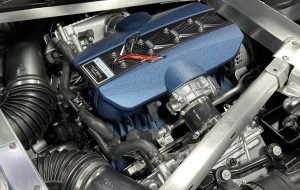When the eighth-generation Corvette made its debut four years ago, some long-time fans questioned how much further Chevrolet could go after rolling out the first mid-engine version of what has come to be known as “America’s sports car.” They got their answer Thursday night when the bowtie brand rolled out what is likely to be the “ultimate” version of the ‘Vette – at least an all-gas model. What’s clear is that the 2025 ZR1 is the fastest, most powerful – and most intimidating model in Corvette history. Here’s a closer look.

The 2025 Chevrolet Corvette ZR1 will be offered in a variety of different configurations, including coupe and convertible.
It’s been 71 years since the Chevrolet Corvette took its first bow. It’s easy to forget that the original version of “America’s sports car” was grossly under-powered, far more show than go. Each generation since then has improved the performance factor, especially the current C8, or eighth-generation ‘Vette, the first to get a mid-engine layout. The latest iteration of the Corvette Z06 readily challenges all but the most exotic offerings from the likes of Aston Martin, Lamborghini and Ferrari. But the bow-tie brand is about to take things to an unheard-of new level with the long-awaited arrival of the 2025 Chevrolet Corvette ZR1.
Even the most jaded sports car fans likely will be blown away by the raw numbers: the new LT7 engine punching out 1,064 horsepower and 828 pound-feet of torque — making it the most powerful V-8 ever produced by an American automaker. Expect a top speed of 215 mph, and quarter-mile runs in the “sub-10 second range,” Chevy promises. It hasn’t released 0-60 times but, based on the launch times of the prior ZR1, something in the mid 2-second range seems likely.
“Years from now, people will look back and say that was the pinnacle of an internal combustion Corvette,” said Harlan Charles, Corvette’s long-time product and marketing manager. And, yes, this very well could be the final purely gas-powered ‘Vette. We’ve already seen the first hybrid, the e-Ray, and Chevy has done nothing to hide the fact that an all-electric model is in the works.
A history of the ZR1
The first Corvette to wear the ZR1 badge – make it ZR-1 back then – hit showrooms during the 1970 model year and was based on the C3, or third-generation sports car.
- Widely known as the “King of the Hill,” it featured a 5.7-liter LT1 small-block V-8 paired with a heavy-duty 4-speed manual transmission, adding better brakes, a retuned suspension and a handful of body tweaks. You couldn’t get niceties like power windows or air conditioning – which may help explain why only 60 examples were built through 1972.
- A more sophisticated version, this time minus the hyphen, followed off the C4 platform and was produced from 1990 to 1995, power came from a, Lotus-engineered 5.7-liter dual overhead camshaft V-8, a rarity in its day. Originally rated 375 hp, it jumped to 405 at the end of its run;
- Surprisingly, the ZR1 badge was put on hold during the C5 era, but it returned for the C6 generation, its new supercharged LS9 V9 delivering 638 hp and 604 lb-ft, cutting 0-60 times to 3.3 seconds;
- The last front-engine Corvette, the C7, introduced the ZR1 as the most powerful model in Chevrolet history, making 755 hp and 715 lb-ft from a supercharged LT5. It was the first to break the 3-second barrier, with all bells-and-whistles making a 0-60 launch in 2.85 seconds.
Meet the LT7
There’s so much to talk about with the 2025 Corvette ZR1 but it seems sensible to begin with the new LT7 V-8.
There’s been plenty of speculation about what route Chevy would take, some expecting to see the ZR1 build on the pluses of the E-Ray, not just the first hybrid in Corvette history but the first all-wheel-drive model. But the automaker took a different path, starting out with the same basic architecture as used for the Z06’s LT6 powertrain.
Renamed the LT7, the 5.5-liter package takes a number of steps to deliver its wheel-spinning power. That includes a flat-plane crank, along with twin microscroll turbochargers and:
- Head castings with unique ports and a larger combustion chamber;
- A completely new intake system;
- CNC machined combustion chamber, exhaust and intake ports; and
- An intelligent, anti-lag engine calibration system.

As with the original C8 Corvette, you can get a glimpse of the LT7 through this partially transparent cover.
To handle all that power, meanwhile, the ZR1 engineering team made numerous updates to the 2-seater’s 8-speed dual clutch transmission.
More Chevrolet Performance News
- The Corvette E-Ray is Fast – and Easy to Live With
- Chevy Builds its Last Camaro – for Now
- These Were Our Top Test Drives
Clearing (and cooling) the air
“Corvette ZR1 is about pushing the envelope with raw power and cutting-edge innovation,” Scott Bell, vice president, Chevrolet.
But the days when you simply needed to add more muscle under the hood are gone. Chevy had to rethink virtually every individual part and component to achieve the max out of the ZR1.
The aerodynamic changes are the most obvious, upon a first look at the new sports car. Along with giving enough air for the engine to breath, and to stay goal, the challenge was to reduce drag even while enhancing down force – normally opposing goals.
The grille takes in air for an intercooled heat exchanger do its job. It then exits through the flow-through hood. This both helps cool charged air temps and increase front downforce. Carbon fiber side ducts, just behind the doors, serve to keep the big rear brakes cooled during hard driving. And carbon fiber inlets on the coupe’s rear hatch help cool those twin turbos.
ZTK performance pack

The 2025 Chevrolet Corvette ZR1 with the ZTX performance pack gets this big wing, among other features.
With the track-focused ZTK performance package ZR1 adds an aggressive, high-downforce rear wing, as well as front drive plans, and a Gurney lip on the front hood – all constructed from woven carbon fiber.
All versions of the ZR1 get the fast-response magnetic ride control suspension, which can go anywhere from full soft to full firm in the time it takes to travel 1 inch at 60 mph. The performance package adds specific upgrades, including stiffer springs.
The ZTK package also adds track-focused Michelin Pilot Sport Cuyp 2-R tires.
Chevy brags that it helped tune the ZR1, and the ZTK package, in particular, on the Nürburgring, Road Atlanta, and Virginia International Raceway.
Return of the split window
For Corvette fans, few things generate more nostalgia than the split window version of the C3 model that was offered during the 1963 model year. In a bit of a surprise, the design of the ZR1 brings back a split window, here for purely functional reasons.
As attractive as the basic C8 generation may be, virtually every change made for this extreme machine was done with a specific reason in mind.
Some of those updates are readily apparent, others more likely to reveal themselves when pushing the ZR1 to the limits. That includes what Chevy describes as a “revolutionary carbon ceramic rotor manufacturing technology meant to hold down brake temperatures and improve durability. The front rotors, at 15.7 inches, are the largest ever on a Corvette. The rear measure 15.4 inches. The automaker claims they help the special edition go from 80 to 200 and back down to 80 mph in just 24.5 seconds.
A bittersweet moment
“We went into the ZR1 program with lofty goals, but even our first development tests on-track showed the teams were already exceeding them,” said Tadge Juechter, executive chief engineer, Corvette. “As we worked to develop this car, we continued to leap past expectations, and we knew we had a special Corvette on our hands.”
Juechter has spent 47 years with General Motors, much of that time with Corvette – serving as chief engineer since 2006, heading both the C7 and C8 programs.
The ZR1 is the last program that Juechter will oversee as he retires and hands Corvette’s reins over to another GM veteran, Tony Roma. Roma has also spent a sizable chunk of his career in the performance world, both with Corvette and Cadillac where he worked on both V-Series models and the recent Blackwing series.

The ZR1’s interior features unique seats, fabrics and, with the infotainment system, features specifically aimed at extreme performance.
Pricing and availability
Chevy has yet to reveal pricing for the new Corvette ZR1 but you can expect it to carry a sizable premium over the Z06 model which runs anywhere from $109,295 up to $130,145, depending upon trim and options.
Chevrolet plans to release pricing and additional specs closer to the on-sale date. It is expected to open up orders months ahead, however.
It will be built at the same Bowling Green, Kentucky assembly plant that currently produces the “base” Stingray, Z06 and E-Ray versions of the Corvette.
Production of the 2025 Chevrolet Corvette ZR1 is set to begin sometime in 2025.















Whatever you guys are doing to my favorite car (CORVETTE) keep doing it the car looks awesome